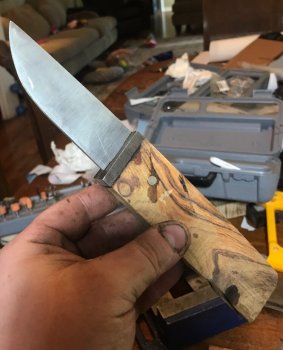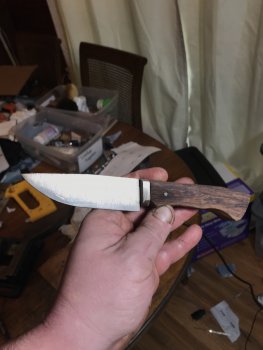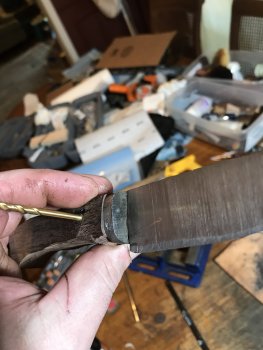I guess it's time for me to share a few things on hidden tangs.......
1.
It is....UNLESS you go to Home Depot, and buy one of the small Ryobi miter saws with the built in laser guide.

Then you fit the guard to the blade, and place it on the handle block you intend to use, at the angle you want.....and use the back of the guard material as a "straight edge" to draw a line on the handle block....then just match the angle on the miter saw (using the laser guide) to the line you've drawn on the handle material. and cut the block to the exact angle of the guard material. Then you don't have to fight with getting the angle correct......just have to fight with drilling/broaching out the hole.
2. Before you ever mix your glue..... and with the guard in it's final fit position, cover the entire blade, and front of the guard with Vaseline.... anywhere you don't want glue to stick. That way IF any glue gets where you don't want it, it pops off easily after curing.... with a sharpened brass rod (brass won't scratch you blade)

3. When gluing on the handle block, use a piece of vulcanized fiber spacer, (black is my preference) and then when you mix your glue, add some pigment to the glue, that matches the color of the spacer material you used. Apply glue to both sides of the spacer material (and fill ANY gap in the back of the guard material with glue) put it in place, then fill the hole in the handle material. This is my "insurance policy"......... ever heard me say..... The difference between a knifemaker, and a good knifemaker is that a good knifemaker knows how to minimize or hide their mistakes? Well in this case, you still have to be VERY close, but if you have a very slight misalignment between the back of the guard and the angle of the handle material......the fiber spacer and the like color glue will make it invisible.

3. With the spacer material in place, GENTLY work the tang into the handle material. In this case "glue overflow" is a good thing....you want to "burp" ALL the air out of the handle material, and have it COMPLETELY filled with glue.
4. SUPER IMPORTANT..... DO NOT use any kind of mechanical/rigid clamp! If you do, the chances are high that when you come back after the glue has cured....there will be a gap somewhere in the assembly. Either use ONLY the weight of the blade/guard, or at most two rubber bands, over the top/bottom front of the guard material. and over the butt end of the handle material.
5. When it comes to placing the pin...... Once the glue has cured, get the handle material to the FINAL profile you want. Then go to the drill press, and START by using a drill bit that is at least 3 sizes smaller than the pin size you intend to use. (I generally use 3/32" pins, which means the hole ends up at a #41.... so I start with a #50. ) Carefully line things out, and drill through the handle material, through the tang, and out the other side. Of course if you hardened the tang, you'll need hi-roc or other carbide bits to do this...but I do not harden tangs. The reason you start small on the bit is because even a screw length bit will flex and "wallow" out the handle material when you hit the tang.......once through with the #50, I then re-drill/ream with a 3/32", and then finally with a #41. This generally eliminates the "glue line" you see around the pin of many hidden tang knives. Gently round the ends of the pin, rough it with 400 grit, apply some glue, and insert the pin.....make it long enough to ensure the radius on the ends are fully outside the hole....otherwise you end up with that "glue line". Let it cure and finish out everything.
Whew! OK, I'm tapped out for today. Hope that info is helpful!

That's just the way Ed does it...... and is certainly not the only way it can be done..... but it's what I've come to over the years of goofing up!
ADDON: After going back and reviewing the pics again, I would also suggest that the blade and front of the guard be 100% completed and finished BEFORE installing the handle......after the guard and handle are installed, it's really difficult to work on the blade, or front of the guard without causing yourself grief.









